 Facebook
Facebook
 X
X
 Instagram
Instagram
 TikTok
TikTok
 Youtube
Youtube
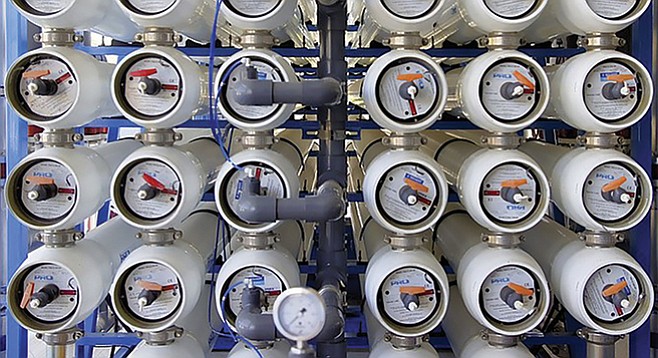
The saga of the city trying to avoid shelling out $2 billion to upgrade the Point Loma Wastewater Treatment Plant continues. The star of this full-length multi-technical feature is the Clean Water Act that mandates publicly owned sewage-treatment facilities use “secondary treatment” to minimize harmful impacts from wastewater that’s dumped into the ocean.
The Point Loma plant has gotten around this knotty issue by applying for waivers every five years since 1995. A new tentative waiver went out for public review on October 28.

The key justification in the city’s latest application was the Pure Water project, which has as its goal taking part of the 160 million gallons of wastewater currently being dumped into the ocean on a daily basis and turning it into drinkable water — 83 million gallons a day by 2035.
The idea of “toilet to tap” didn’t receive much cheerleading until 2011 when mayor Jerry Sanders endorsed the idea and a pilot project began in Miramar. The city shelling out $2.5 million for some hardcore public relations starting in 2010 didn’t hurt.

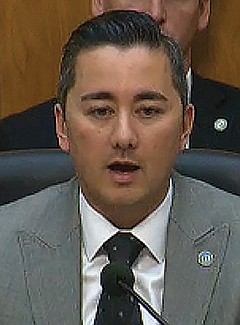
Local lobbyist Lani Lutar was part of that effort starting as early as 2013, as evidenced by a signed commitment letter and lobbying disclosure forms. While being compensated by the city for Pure Water outreach, Lutar was lobbying the city on behalf of firms interested in Pure Water contracts. She was also busy with local campaign fundraisers — including for Chris Cate, with whom she used to lobby. In 2013, Cate lobbied both his future District 6 office and the mayor’s office regarding water policy.
During this same period, Lutar was also the main point of contact for the Water Reliability Coalition and on the board of Mayor Faulconer’s nonprofit. The former is a diverse group focused on moving forward water-recycling projects like Pure Water, while the latter is Faulconer’s brain-child focused on educating the public on public policy by hosting community events “to relieve the [city] of the costs and burden of conducting activities on behalf of the office of the Mayor.”
Of the five big Pure Water contracts totaling $102 million awarded since 2010, Lutar has connections to all of them — either having lobbied specifically on the future contractor’s behalf or as a group via the Water Reliability Coalition.
The starkest example is with the most recent Pure Water contract awarded in October for the pump station on Morena Boulevard. The winner of this $15 million contract was AECOM. In 2015, Lutar collected $55,000 from AECOM to lobby the mayor and members of the city council while also collecting $43,060 from the city’s public utilities department for Pure Water public outreach. In addition, she was compensated $13,000 from a North County water district for lobbying the City of San Diego’s Public Utilities department, the mayor’s office, and every single councilmember’s office regarding recycled-water rates.
Anyone who has been watching the Pure Water saga recalls the original plan was to produce 15 million gallons per day of drinking water out of Miramar by 2023, another 15 million gallons at South Bay by 2027, and 53 million gallons coming from the Central Area by 2035.
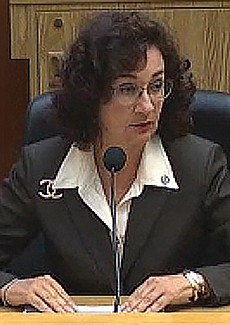
Public Utilities Department director Halla Razak discussed the change of plans in front of the city council and those protesting the changes on October 25. “When we started looking closer at the design elements of the first 15 [million gallons a day of drinking water at Miramar], it became very quickly evident that we didn’t have enough wastewater flow to in fact generate both the purple pipe water [for industrial use] and the commitments we have, as well as the 15 [million gallons of drinking water].”
Razak went on to explain that a total wastewater flow of 32.4 million gallons a day was needed and all they had was 26.3 million gallons flowing in from Peñasquitos Pump Station 64. This is when Razak’s department switched gears and landed on doubling the output to 30 million gallons per day of drinking water out of Miramar by 2021 and building a pump station on Morena Boulevard to solve the sewage-flow shortage. Razak said not only will it save millions of dollars, but it’ll double the drinking water output six years ahead of schedule — 30 million gallons per day in 2021 versus 2027.
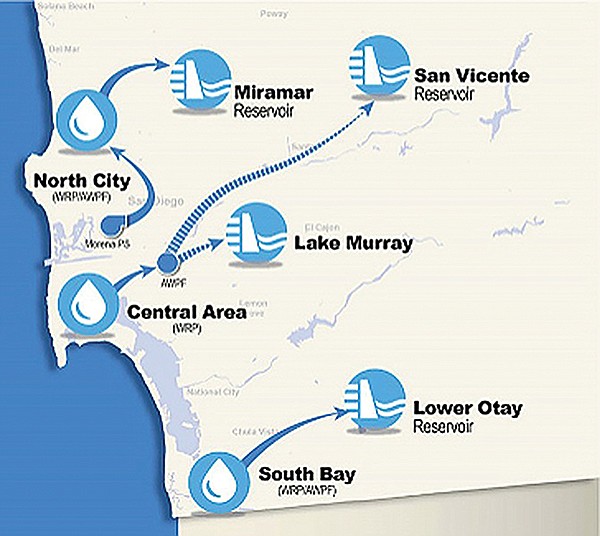
As for now, the second phase of Pure Water is still to produce an additional 53 million gallons per day of drinking water by 2035 out of the Central Area (San Vicente and Lake Murray reservoirs) and South Bay (Lower Otay Reservoir).
Despite the impressive feat of doubling the output of locally produced drinking water six years ahead of schedule, there are still a few possible hitches around the bend.
The issue of the Point Loma plant needing to apply for another waiver before Pure Water goes online is a concern for some. The 2014 cooperative agreement between the city and some environmental groups does give the city some respite in regards to Point Loma. The agreement states that if legislative relief isn’t obtained before the next waiver application is submitted in 2019, the agreement is over and out. The waiver can also be revoked if testing shows outflow quality degrading, according to Nahal Mogharabi from the Environmental Protection Agency.
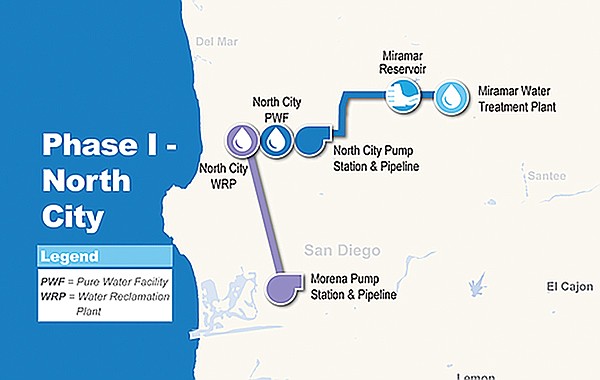
The stickiest wicket is that of cost. While there are no hard numbers, when all is said and done the price tag will likely be around $3 billion; Razak estimates the first phase of the project will come in at $1 billion.
At the October 25 city-council meeting, a speaker opposed to the project pointed to the Carlsbad desalination plant, which opened a year ago, already producing 50 million gallons per day. He said that with other sources like this coming online soon, the Pure Water project will be redundant when it finally gets up and running.
“It’s minimal in its impact and it’s maximum in its cost. You are spending the equivalent to four new stadiums and you don’t even have the scientific study in your hand to make that decision.”
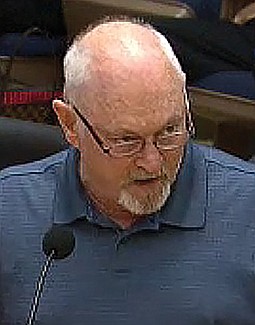
The Metro Wastewater Joint Powers Authority consists of municipalities and special districts that use the City of San Diego’s wastewater facilities. They foot around one-third of the bill. In October, this group voted against the Pure Water project. Jerry Jones, a Lemon Grove city councilmember and member of the water authority, explained the vote: “It’s not because they’re opposed to the project, it’s more the timeline and cost that are causing the rift.
“The concern and disagreement began in July when [city] staff informed the [group] that milestones and expenditures, which were not expected for ten years, were to be moved up to present planning. That change in plans came with a $400 million price tag.”
Jones said the main reason given by city staff was that due to drought conservation, there just wasn’t enough wastewater flow to meet the 2023 milestones to have 15 million gallons of drinking water per day.
“At that time we had no data to confirm the decreased flows and no financial data to understand what the costs would be, what we were paying for, or how this would impact our ratepayers.”
Jones said financial experts estimated a potential rate increase as high as 80 percent. He also said that wastewater ratepayers in other cities would be subsidizing water customers in the City of San Diego. Jones called this out as a violation of Proposition 218.
Proposition 218 is a 1996 California constitutional article that indicates the city can’t implement new rates if the majority of citizens protest the rates in writing. This could jeopardize the project if the public doesn’t support future rate hikes.
“Our concern,” Jones says, “is that the changes are being rushed ahead of work that needs to be done to secure secondary [treatment] equivalency though a congressional waiver.”
Jones said that even though local environmental stakeholders are committed to securing a permanent congressional waiver, he thinks that it could be a can of worms that might not fly in Washington or with national environmental groups.
Two other important issues still in limbo for the city are figuring out how to train operators to work with both drinking water and wastewater — this ought to be spelled out in an engineering report due out in early 2017 — and what exactly the state-level recycling criteria is for Pure Water. It’s telling that the draft criteria out for public review in October was littered with this phrase: “knowledge gaps.”


The saga of the city trying to avoid shelling out $2 billion to upgrade the Point Loma Wastewater Treatment Plant continues. The star of this full-length multi-technical feature is the Clean Water Act that mandates publicly owned sewage-treatment facilities use “secondary treatment” to minimize harmful impacts from wastewater that’s dumped into the ocean.
The Point Loma plant has gotten around this knotty issue by applying for waivers every five years since 1995. A new tentative waiver went out for public review on October 28.

The key justification in the city’s latest application was the Pure Water project, which has as its goal taking part of the 160 million gallons of wastewater currently being dumped into the ocean on a daily basis and turning it into drinkable water — 83 million gallons a day by 2035.
The idea of “toilet to tap” didn’t receive much cheerleading until 2011 when mayor Jerry Sanders endorsed the idea and a pilot project began in Miramar. The city shelling out $2.5 million for some hardcore public relations starting in 2010 didn’t hurt.


Local lobbyist Lani Lutar was part of that effort starting as early as 2013, as evidenced by a signed commitment letter and lobbying disclosure forms. While being compensated by the city for Pure Water outreach, Lutar was lobbying the city on behalf of firms interested in Pure Water contracts. She was also busy with local campaign fundraisers — including for Chris Cate, with whom she used to lobby. In 2013, Cate lobbied both his future District 6 office and the mayor’s office regarding water policy.
During this same period, Lutar was also the main point of contact for the Water Reliability Coalition and on the board of Mayor Faulconer’s nonprofit. The former is a diverse group focused on moving forward water-recycling projects like Pure Water, while the latter is Faulconer’s brain-child focused on educating the public on public policy by hosting community events “to relieve the [city] of the costs and burden of conducting activities on behalf of the office of the Mayor.”
Of the five big Pure Water contracts totaling $102 million awarded since 2010, Lutar has connections to all of them — either having lobbied specifically on the future contractor’s behalf or as a group via the Water Reliability Coalition.
The starkest example is with the most recent Pure Water contract awarded in October for the pump station on Morena Boulevard. The winner of this $15 million contract was AECOM. In 2015, Lutar collected $55,000 from AECOM to lobby the mayor and members of the city council while also collecting $43,060 from the city’s public utilities department for Pure Water public outreach. In addition, she was compensated $13,000 from a North County water district for lobbying the City of San Diego’s Public Utilities department, the mayor’s office, and every single councilmember’s office regarding recycled-water rates.
Anyone who has been watching the Pure Water saga recalls the original plan was to produce 15 million gallons per day of drinking water out of Miramar by 2023, another 15 million gallons at South Bay by 2027, and 53 million gallons coming from the Central Area by 2035.

Public Utilities Department director Halla Razak discussed the change of plans in front of the city council and those protesting the changes on October 25. “When we started looking closer at the design elements of the first 15 [million gallons a day of drinking water at Miramar], it became very quickly evident that we didn’t have enough wastewater flow to in fact generate both the purple pipe water [for industrial use] and the commitments we have, as well as the 15 [million gallons of drinking water].”
Razak went on to explain that a total wastewater flow of 32.4 million gallons a day was needed and all they had was 26.3 million gallons flowing in from Peñasquitos Pump Station 64. This is when Razak’s department switched gears and landed on doubling the output to 30 million gallons per day of drinking water out of Miramar by 2021 and building a pump station on Morena Boulevard to solve the sewage-flow shortage. Razak said not only will it save millions of dollars, but it’ll double the drinking water output six years ahead of schedule — 30 million gallons per day in 2021 versus 2027.

As for now, the second phase of Pure Water is still to produce an additional 53 million gallons per day of drinking water by 2035 out of the Central Area (San Vicente and Lake Murray reservoirs) and South Bay (Lower Otay Reservoir).
Despite the impressive feat of doubling the output of locally produced drinking water six years ahead of schedule, there are still a few possible hitches around the bend.
The issue of the Point Loma plant needing to apply for another waiver before Pure Water goes online is a concern for some. The 2014 cooperative agreement between the city and some environmental groups does give the city some respite in regards to Point Loma. The agreement states that if legislative relief isn’t obtained before the next waiver application is submitted in 2019, the agreement is over and out. The waiver can also be revoked if testing shows outflow quality degrading, according to Nahal Mogharabi from the Environmental Protection Agency.

The stickiest wicket is that of cost. While there are no hard numbers, when all is said and done the price tag will likely be around $3 billion; Razak estimates the first phase of the project will come in at $1 billion.
At the October 25 city-council meeting, a speaker opposed to the project pointed to the Carlsbad desalination plant, which opened a year ago, already producing 50 million gallons per day. He said that with other sources like this coming online soon, the Pure Water project will be redundant when it finally gets up and running.
“It’s minimal in its impact and it’s maximum in its cost. You are spending the equivalent to four new stadiums and you don’t even have the scientific study in your hand to make that decision.”

The Metro Wastewater Joint Powers Authority consists of municipalities and special districts that use the City of San Diego’s wastewater facilities. They foot around one-third of the bill. In October, this group voted against the Pure Water project. Jerry Jones, a Lemon Grove city councilmember and member of the water authority, explained the vote: “It’s not because they’re opposed to the project, it’s more the timeline and cost that are causing the rift.
“The concern and disagreement began in July when [city] staff informed the [group] that milestones and expenditures, which were not expected for ten years, were to be moved up to present planning. That change in plans came with a $400 million price tag.”
Jones said the main reason given by city staff was that due to drought conservation, there just wasn’t enough wastewater flow to meet the 2023 milestones to have 15 million gallons of drinking water per day.
“At that time we had no data to confirm the decreased flows and no financial data to understand what the costs would be, what we were paying for, or how this would impact our ratepayers.”
Jones said financial experts estimated a potential rate increase as high as 80 percent. He also said that wastewater ratepayers in other cities would be subsidizing water customers in the City of San Diego. Jones called this out as a violation of Proposition 218.
Proposition 218 is a 1996 California constitutional article that indicates the city can’t implement new rates if the majority of citizens protest the rates in writing. This could jeopardize the project if the public doesn’t support future rate hikes.
“Our concern,” Jones says, “is that the changes are being rushed ahead of work that needs to be done to secure secondary [treatment] equivalency though a congressional waiver.”
Jones said that even though local environmental stakeholders are committed to securing a permanent congressional waiver, he thinks that it could be a can of worms that might not fly in Washington or with national environmental groups.
Two other important issues still in limbo for the city are figuring out how to train operators to work with both drinking water and wastewater — this ought to be spelled out in an engineering report due out in early 2017 — and what exactly the state-level recycling criteria is for Pure Water. It’s telling that the draft criteria out for public review in October was littered with this phrase: “knowledge gaps.”
Comments